|
Wisley's Alpine Log
By Paul Cumbleton
Log 16 --- 31 July 2008
PONERORCHIS
A couple of logs ago I showed a picture of one of our Ponerorchis. A subsequent comment on the forum asked if I could show more of these so here I am happy to oblige. These plants used to be within the genus Orchis, but a small number of species have been moved to their own genus of Ponerorchis. I have to confess I do not find these plants easy to grow - they far too easily rot off at the base of the stems. So I am still experimenting with them to find a good growing medium and watering regime that may reduce these problems. But when they do grow, the beautiful flowers are worth the effort.
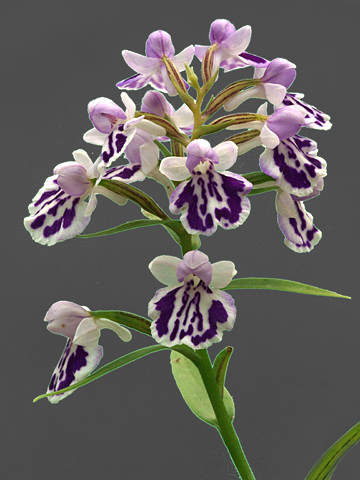
Ponerorchis 001
Each stem grows from a small, finger-like tuber which look like this:
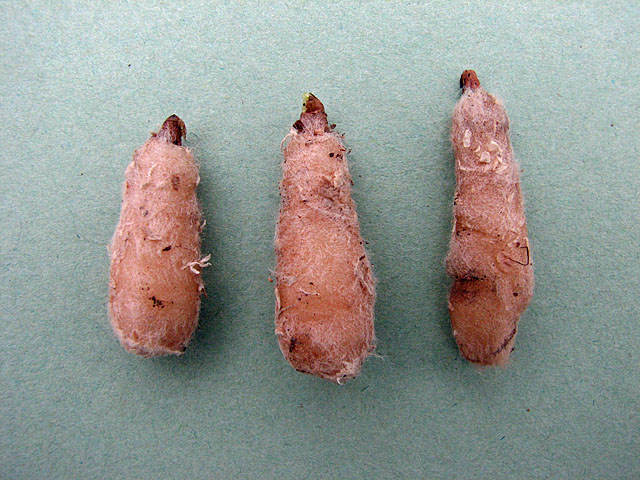
Ponerorchis tubers
These can split along their length to make new tubers, so giving vegetative increase. In this next picture, you can see on the left a tuber where this process has started, and on the right one where it is well advanced:
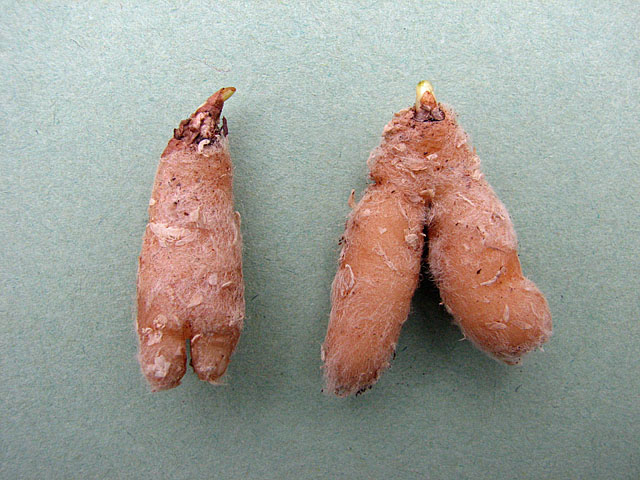
Ponerorchis tubers splitting
Sometimes instead of splitting in this manner, a new small tuber will form on the side of the old one, like this:
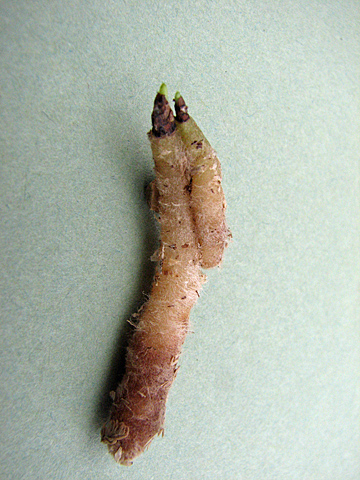
New tuber development
Ponerorchis are extremely popular in Japan where they have been hybridised and good forms selected for many years. Here in the UK these are rarely seen and almost impossible to obtain. We have been fortunate in that a friend and benefactor who often travels to Japan has bought plants there for us and brought them back to Wisley. I cannot give you names for the pictures - they are all selected but un-named seedlings of hybrids. The Japanese have a system that gives names which describe the colour and shape of the flowers, but these are not cultivar names as we would understand them.
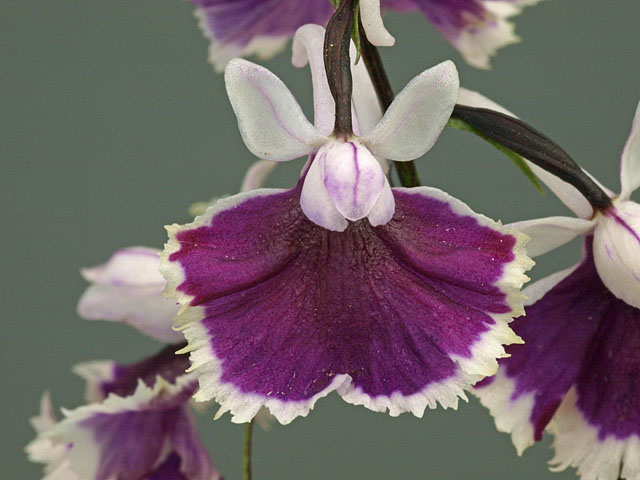
Ponerorchis 002
As these plants are rarely grown outside of Japan, there is very little information about them available in English - if you look on the web, the vast majority of references are in Japanese. I am therefore going to reproduce here the only useful article available in English which was written by Gunther Kleinhans and first published in 'The Pleione Review' (a magazine I used to publish myself but which is no longer in print). I will insert pictures as it goes along to break up the text and show some of the beautiful flowers. Here is the article:
The Japanese Culture of UTYOURAN - Ponerorchis graminifolia
Gunther Kleinhans describes the many beautiful hybrid forms of Ponerorchis that have been raised in Japan and details their cultivation…
Ponerorchis is a small genus of mostly terrestrial orchids closely related to the well-known genus Orchis, to which it was, at times, considered to belong. The Botanist H. G. Reichenbach proposed in 1852 to place it in a newly created genus, Ponerorchis, and after several reconsiderations this name is still valid today. (In 1972 P. Vermuelen confirmed the genus as a distinct group of East Asian orchids being closely related to Orchis, with which it shares spherical, ellipsoid or oblong tubers. The column has two bursicles that enclose the pollinia, whereas Orchis has only a single bursicle.) The genus comprises several species growing in mountainous habitats throughout Eastern Asia, and three of them are known to be native to Japan. The three species are P. chidori (which is said to also grow epiphytically), P. joo-iokiana, and P. graminifolia. The latter is also native to Southern Korea, where it grows, as in Japan, on grassy land in temperate, mountainous regions. Only P. graminifolia has been used for exte
nsive breeding work that began before the Second World War and continues until today. Here the name "Ponerorchis" clearly lies - it refers to a plain or ugly relation of the European genus Orchis, whereas in fact Ponerorchis offers some of the more spectacular plants suitable for the alpine house. P. graminifolia is a small, finely structured, fragile and grass like plant. The variety in flower colour and shape has caught the attention of Japanese plant enthusiasts, who generally treasure very much their native flora.
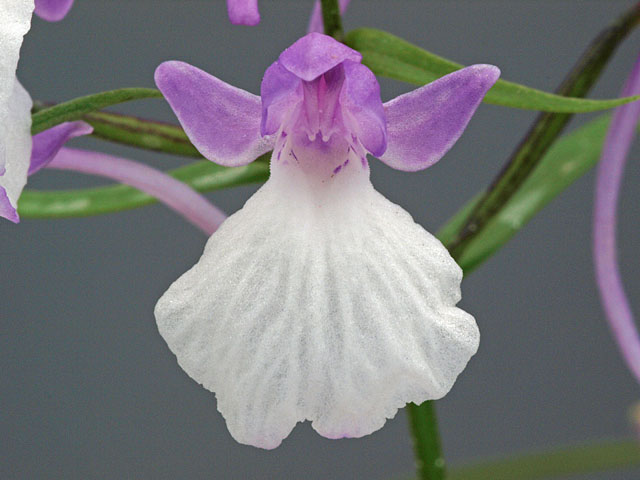
Ponerorchis 003
I found a short article in "The New Plantsman" Vol.1, Part 1, 1994. Hybridisation has been mentioned between P. graminifolia and P. chidori, and between P. graminifolia and Amitostigma gracile, and took place decades ago. It may very well be possible that the offspring of these earlier hybrids have been used for further breeding, because today's Ponerorchis graminifolia cultivars show an amazing array of variety. Besides the article in the "New Plantsman" I checked in some other, Japanese books, where also three varieties of P. graminifolia were mentioned. They only show, however, variety in the colour pattern of the flower, and much less in its shape. The varieties are: kurokamiana, suzukiana and micropunctata. The Japanese name for P. graminifolia is UTYOURAN, and I will use the latter expression to refer to the wonderful results of the concentrated breeding efforts undertaken by Japanese florists (in the old fashioned British sense).
Japanese plantsmen have a long history of selecting and breeding some of the most wonderful cultivars of ornamentals, and UTYOURAN is just one of them. 150 years ago, when the plant world (this time not just the Royalty) went wild on Far Eastern introductions, many of their plants became accessible through shows and public gardens. There were Chrysanthemum shows in many of the big cities all over the world. Europeans were fascinated by the selections of Adonis amurensis, where plants other then the plain yellow singles have been collected: green, white, bronze and red; also showy doubles. After the last world war, when income grew, Japanese horticulturists caused regular booms for plant specialties among the interested population. BONSAI became fashionable again, and a bit later UTYOURAN were a big hit.
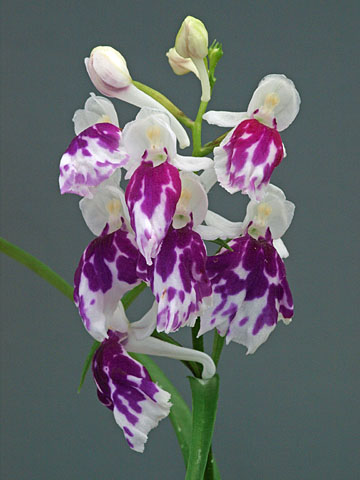
Ponerorchis 004
Most Japanese plant enthusiasts have the desire and a special craving for things small, unusual and precious, and many Japanese nurseries and garden centres cater to these needs and desires by offering a wide range of small and delicate ornamental plants. About 35 years ago UTYOURAN reached its peak in cultivation. Its cult-like following paid very high amounts of money to get a desired cultivar, and many of today's named cultivars originate from this time: names sell!
The enthusiastic following, however, has changed during the last 20 years to another Japanese oddity, Hepatica nobilis var. japonica, called YUKIWARISO, with its myriads of flower and colour mutations. Nowadays there is a rather small circle of UTYOURAN enthusiasts left, and many of the former stars of the show bench are now available in larger quantities for much lower prices. There is still an annual UTYOURAN exhibition in Tokio during the first weekend of June at the "Greenclub" where, during the rest of the year, members of many other specialized plant groups and societies eagerly display their favourite ornamentals with considerable dedication.
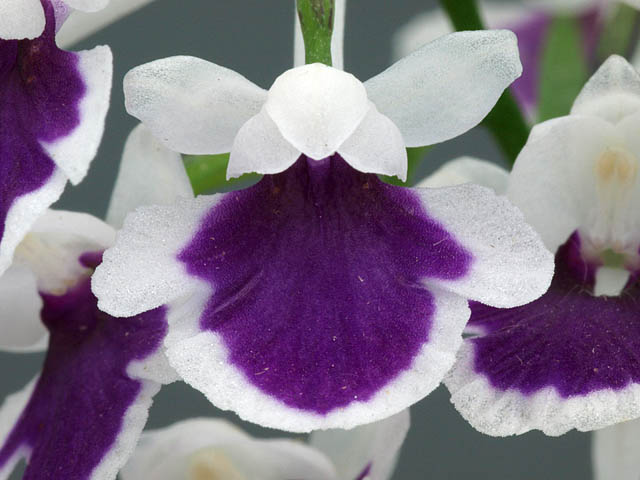
Ponerorchis 005
The Cultivars of UTYOURAN
The flowers of UTYOURAN found in nature are generally not very interesting: small, maybe half an inch tall and a quarter of an inch wide, nice, but not very showy with their whitish and pink flowers displaying spots or patches in darker pink or magenta colours. A large amount of seedlings in cultivation turn out this way; they are inexpensive, cute little plants. Five to twenty blossoms can usually be found on its single flower truss.
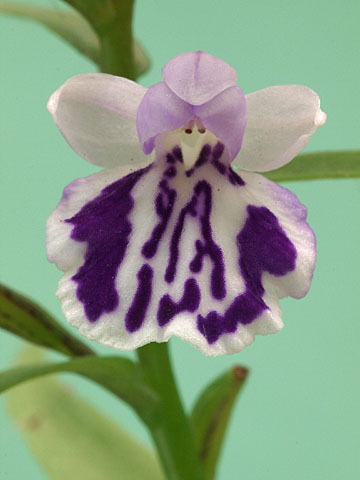
Ponerorchis 006
Dedicated horticulturists, however, were able to produce quite stunning results through crossing, sowing, selecting, again crossing, sowing, selecting and so on: flowers an inch tall, and some cultivars with blossoms even wider. Only a small percentage of the offspring produces plants of desirable flower size, shape and colour pattern. There is a "floristic" system that I would like to point out to you, that describes the flower shapes and colours:
Flower Shapes
HYOJYUNKA: The "natural" flower shape, exhibited by most plants, has a lip with three lobes: the two side lobes point down, and are less prominent than the middle lobe. Desirable cultivars have, of course, larger flowers than common plants, as well as a strong and distinctive colour pattern. You will find the most common colour patterns described below; they can apply to all of the flower shapes.
NIOH: The lip's side lobes are much more prominent, often overlapping the middle lobe and, in many cases, resemble ears. The ears vary in size, and equal or surpass the middle lobe in its colour pattern. A large selection of outstanding NIOHs is available, and it is probably the most beautiful of UTYOURAN's flower shapes.
RENZETSU: This shape is relatively rare, and therefore expensive. Most or all of the two side lobes are integrated, together with the middle lobe, into one structure; many cultivars appear to have no lobes, but a lip that is as wide as it is long. Different colour patterns exist.
KAPUTO-ZAKI: This funny name refers to all plants that cannot be placed into the other shapes. It consists of plants developing (consistent, not occasional) monstrous flowers, flowers crippled through what looks like virus infection, and any flower that is odd and does not fit into the pattern of the other shapes. Among these plants are the most spectacular: side lobes may by far surpass the size of the middle lobe, spreading like wings, the blossoms large enough to resemble small humming birds in flight - really wonderful!
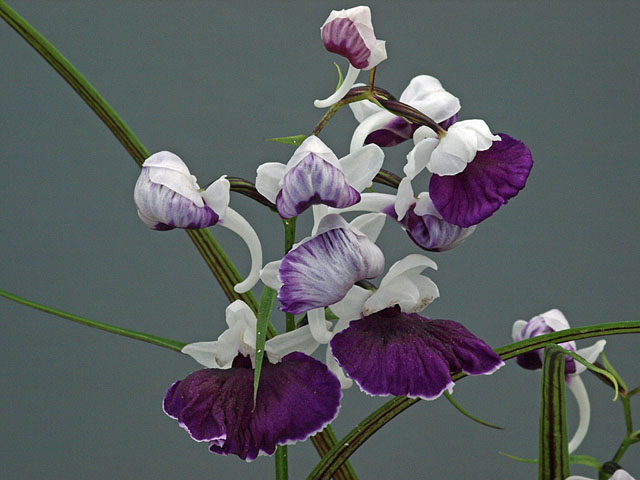
Ponerorchis 007
Flower Colour
The colours displayed by UTYOURAN are various: there are greens, yellows and white, sometimes pure but mostly combined with the common shades of pink. The lips' patterns are usually of darker colour: dark pink, magenta, purple to dark purple, but there are also plenty of 'blushes', where the colour runs as on a still fresh watercolour painting - very nice!
This is a selection of the more common colour patterns; there are some others. Many enthusiasts gave up on naming them because each new generation might display something new. The colour patterns usually concentrate on the blossom's lip section.
SHIRO: pure white flower, albino. Here is an example:
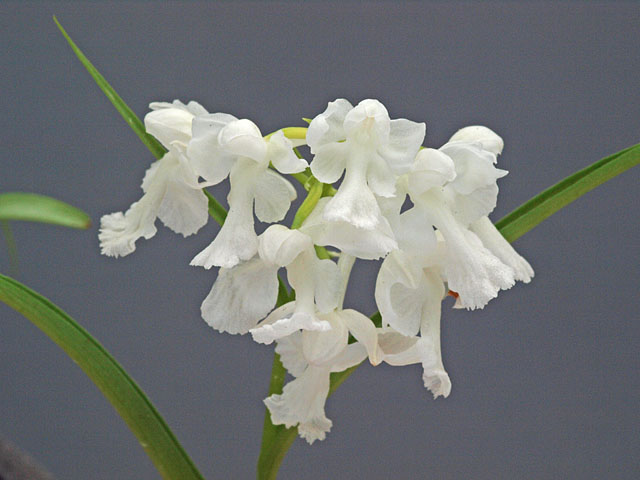
Ponerorchis 008
SHIROSHITEN: white flower with small, magenta spots
SHIITTEN: white basic colour with a large, dark magenta blotch
HANMONKA: with small or larger spots distributed on a lighter pink flower
KOUITTEN: pink basic colour with a large, dark magenta blotch. This is an example:
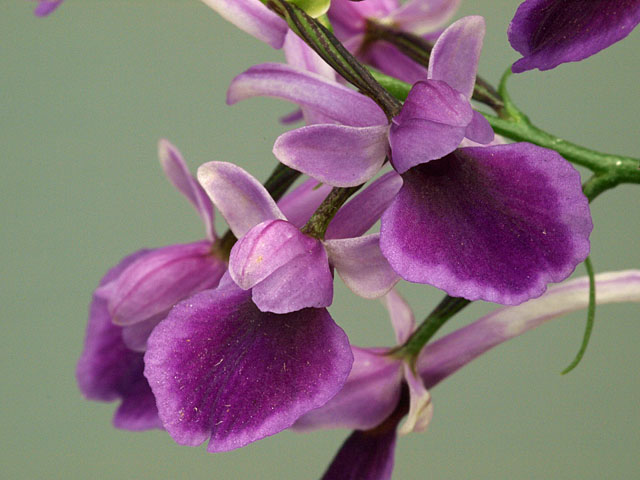
Ponerorchis 009
BOKASHI: centre of the lip is lighter than the basic colour, watercolour-like
NIJI: similar to BOKASHI, where the blush extends over all the lobes of the lip
Among the most spectacular colour patterns are plants with "freckled" flowers: irregular (not round) spots all over, and not just on the lip. There are also the plants that have flower trusses with blossom of different colours, some white, some pink. Other, very rare plants may even have blossoms with their basic colour vertically divided; one half is white, the other one is pink. Yellow blooming plants are the rarest, whilst greens mostly occur on monstrous flowers.
The Flower Truss
UTYOURAN bear flower trusses similar to our native Orchis and Dactylorhiza, but they often carry their blossom more loosely. The trusses become more substantial with age. Usually, seedlings bloom in the third or fourth year after sowing, starting with a few, rather small flowers. After five years of good cultivation the single blossoms reach their full size, and strong plants develop around fifteen flowers on their truss.
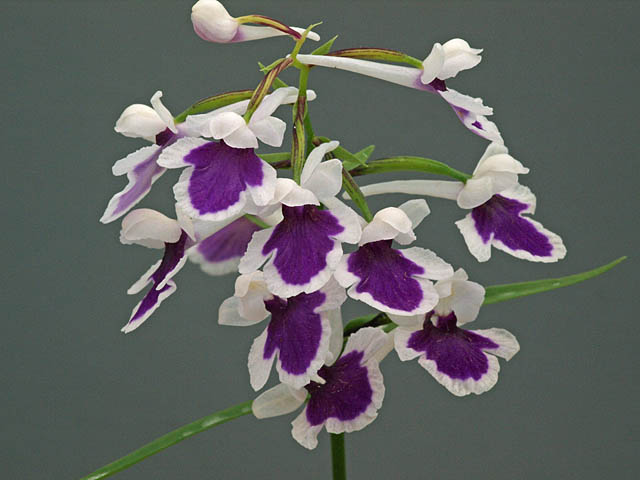
Ponerorchis 010
Leaves
There are some cultivars that are kept mainly for their foliage; most of those have variegated leaves, and some bear crippled, curly or rolled foliage. By "crippled" I mean the leaves are not their natural shape, but are bent, bubbly, twisted and turned. Many of these plants are very weak and often die after a few years.
Care and Cultivation of UTYOURAN
UTYOURAN may be of great interest to the Pleione lover since its requirements are similar to those of pleiones: a semi-shady place with a moist atmosphere and plenty of fresh air. During most of the autumn, winter, and again most of the spring, while dormant, no water is needed, but the air should be sufficiently moist (as for Pleione). Temperatures during the peak of dormancy, in winter, should be around 0 to 5° C, again, similar to Pleione. Please consider that they grow in very loose soil and are covered with heavy snow during winter, therefore protection against frost is needed. The cultivation instructions in the "Plantsman" article do NOT apply to "normal" cultivation of UTYOURAN: they were given by Japanese growers to force a shipment of plants into flower, for display at the 14th World Orchid Conference in Glasgow. The Conference took place in April, while in nature the plants usually bloom in July. Flowering in Japanese cultivation takes place in June.
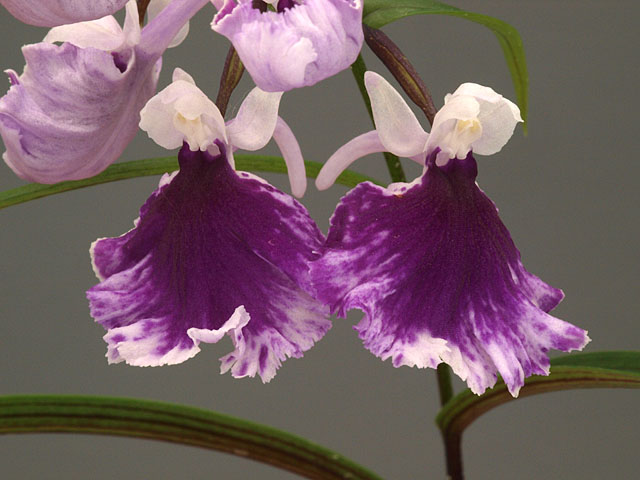
Ponerorchis 011
Pots, Medium and Fertiliser
Unlike Pleione, UTOUYORAN develop only a very few and thick roots that like to grow vertically down into the soil: deep pots, not pans, with a large drainage hole are required. The plants like to grow in a light and loose medium with perfect drainage. The Japanese use a fine grainy medium that resembles coarse sand, but it is porous and much lighter. It consists of unburned miniature clay pebbles. This material is not available in our garden centres. Therefore, experiments should be conducted, trying different materials to optimise growth. The following medium can be used without fatalities on behalf of the plants, but as just mentioned further improvements might be required. The mix could consist of two parts finely beaten Seramis© (without the dust), one part fine perlite (again, without the dust) and one part dark, loose humus. This medium should be pH-neutral. It needs to be replaced for each new growing season to assure that the humus doesn't compact, blocking the required free drainage. To grow substant
ial tubers, bearing large flower trusses with lots of large blossoms, fertilisation is required. Japanese growers use a balanced organic slow-release fertiliser, which is placed on the soil surface and releases its nutrients during watering.
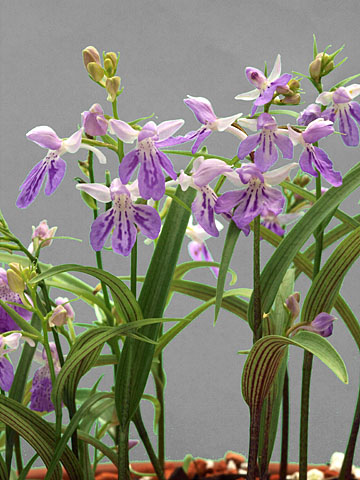
Ponerorchis 012
The Growing Season
Between the end of March and the middle of April newly purchased tubers should be planted, or older ones replanted. For a single tuber a deep pot of not more than three inches wide is suitable, but plants probably look better if they are grown in small groups of one single cultivar. The tubers' eyes, from which the growth originates, must be on top, and should be covered by about half an inch of substrate. Distance between tubers should also be about half an inch.
Once the temperature rises (slowly and gradually, a sudden increase will make the plants "shoot") the growth will finally show up on the surface and slowly grow taller, unfold its leaves and later burst into flower. Flowering may last up to a month, after that the plants remain green until the late summer or early fall; all upper parts of the plants will have died by then. The tubers' roots will eventually also die while the plant is getting ready for its long dormancy.
Watering should begin once the growth shows up on the soil surface, and fertilisation two or three weeks after. Both continue until shortly after the leaves have died, when the temperature gradually begins to fall to autumn levels. Between waterings, the medium's surface should be allowed to dry. During the months of dormancy plants must be kept cold, and no water should be given until the next spring.
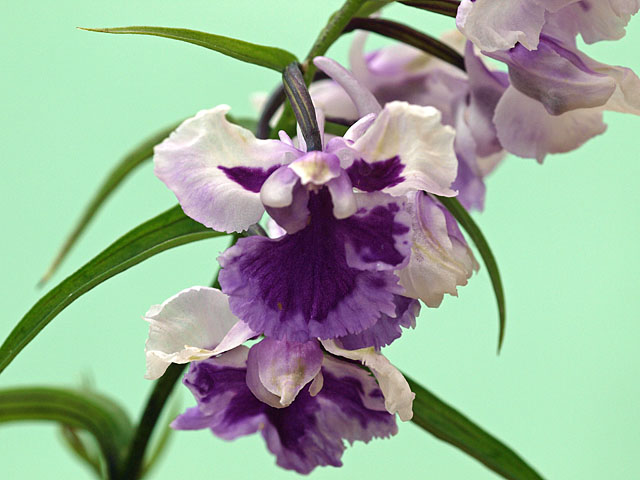
Ponerorchis 013
Pests
The most likely pests are aphids and hungry snails and slugs; you know what to do!
Propagation
Growing UTYOURAN from seed needs experience and takes a lot of time, but is the only way, unless one finds an occasional sport, to develop new beautiful cultivars. The seedlings usually need three or four years until they flower for the first time. Large tubers develop new tubers on their sides. At some point these clusters fall apart, and the single tubers can now be planted separately.
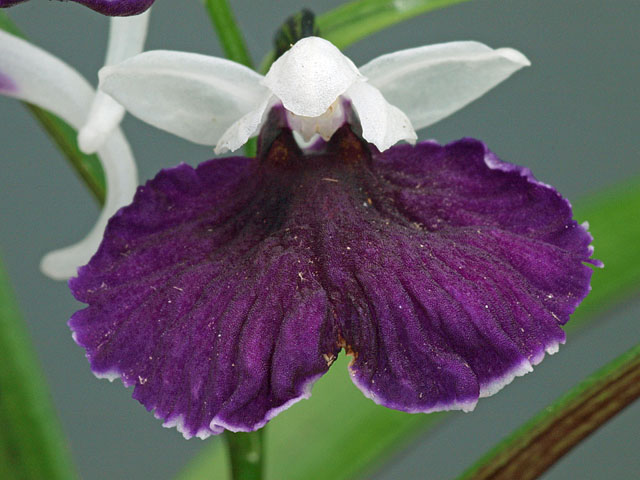
Ponerorchis 014
Availability
UTYOURAN are currently little known and rare plants in Europe. Unclassified common plants, and the more common of the named cultivars are readily available from Japanese growers and should be shipped via express during dormancy. To get more exciting, new and as yet unnamed cultivars, the following is recommended: visit a large UTYOURAN-breeding-nursery in Japan during flower in June, when other enthusiasts and nursery owners flock in to select plants from the seedlings blooming for the first and second time.
To prepare these plants for shipment to Europe they should be taken out of their pots and substrate, the tubers and roots should be loosely wrapped with moist tissue surrounded by an open plastic foil (to prevent the plants from rotting). The flowering plants can now be loosely placed into a strong wooden box which is large enough to accommodate the whole plant without bending, breaking or smashing the stems, leaves, flower trusses and blossom. The plants are fine for two to three days. Once at home, they must be repotted as fast as possible and placed in a cool and airy place without direct exposure to the sun.
As when importing most or all orchids, Ponerorchis require CITES permits (and a Plant Health Certificate). To get CITES can be quiet a pain due to the paperwork. However, if one can prove that the plants are cultivated, which should be easy in this case, gaining CITES permits should be easy. Nobody wants the wild ones: they are much too plain.
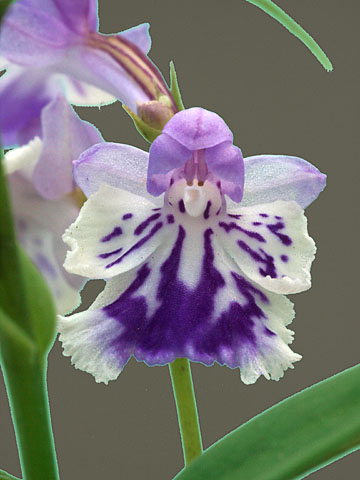
Ponerorchis 015
^ back to the top ^
|

